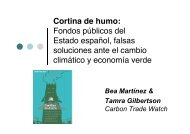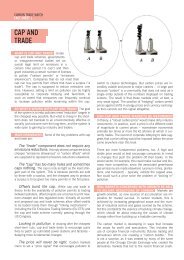The Sky is Not the Limit: - Carbon Trade Watch
The Sky is Not the Limit: - Carbon Trade Watch
The Sky is Not the Limit: - Carbon Trade Watch
- No tags were found...
You also want an ePaper? Increase the reach of your titles
YUMPU automatically turns print PDFs into web optimized ePapers that Google loves.
2.6 Sinking <strong>the</strong> ProtocolBonn 2001: After <strong>the</strong> climatenegotiations came to a standstill atCOP6 in Den Haag in 2000, dramaticpolitical events such as <strong>the</strong> USrejection of <strong>the</strong> Kyoto Protocol andsubsequent comprom<strong>is</strong>e dealsfundamentally undermined reductiontargets. <strong>The</strong> departure of <strong>the</strong> USpushed <strong>the</strong> Protocol to <strong>the</strong> edge. COP-6.5 in Bonn <strong>the</strong> following year wasintended to save <strong>the</strong> Kyoto Protocol.<strong>The</strong> overwhelming majority ofgovernments and NGOs rushed tocomprom<strong>is</strong>e, in <strong>the</strong> hope of keepingsceptical governments on board andtrying to win <strong>the</strong> US back. Weakenedrules in <strong>the</strong> Bonn agreement,combined with <strong>the</strong> departure of <strong>the</strong>US, mean em<strong>is</strong>sions reductions mayonly be 0.1 per cent of 1990 levels for<strong>the</strong> rich industrial<strong>is</strong>ed countries. 1Negotiating positions developed overmany years were dropped in Bonn.One of <strong>the</strong> most important was <strong>the</strong>proposed cap on em<strong>is</strong>sions trading, toprevent countries from achieving 100per cent of <strong>the</strong>ir targets abroad. <strong>The</strong>Kyoto Protocol stated that tradingshould be supplementary to reducingem<strong>is</strong>sions directly at source. However,what ‘supplementary’ meant had notbeen quantified. A cap would definethat and <strong>the</strong> EU had been arguing fora 50 per cent limit on trading. <strong>The</strong>Bonn agreement only made arecommendation that “domestic actionshall thus constitute a significantelement of <strong>the</strong> effort.” Th<strong>is</strong> was despiteprotest against em<strong>is</strong>sions trading andarguments that carbon trading wouldbe a new form of colonial<strong>is</strong>m. 2 <strong>The</strong>only potential environmental ‘win’ wastext in <strong>the</strong> agreement that countriesshould ‘refrain from using nuclearpower’ in em<strong>is</strong>sions trading projects.However long d<strong>is</strong>cussions on sinkscame to a bitter end and <strong>the</strong>y are nowpresent in <strong>the</strong> CDM.<strong>Carbon</strong> SinksSinks refers to <strong>the</strong> use of trees, soilsand oceans to absorb carbon dioxidefrom <strong>the</strong> atmosphere. While <strong>the</strong>science of sinks <strong>is</strong> still uncertain,<strong>the</strong>re <strong>is</strong> a broad consensus that anypotential storage of carbon <strong>is</strong>temporary as trees naturally live out<strong>the</strong>ir life cycles or are felled and <strong>the</strong>resultant carbon <strong>is</strong> ultimatelyreturned to <strong>the</strong> atmosphere. Manyenvironmental<strong>is</strong>ts and indigenouscommunities around <strong>the</strong> world fearthat use of sinks will have anegligible impact on reducing globalwarming while having an enormousimpact on people worldwide as poorcountries, desperate to earn moneyto pay back debts, look to selling<strong>the</strong>ir lands and forests for <strong>the</strong> carbonmarkets.Projects in countries such as Ugandaand Ecuador have already led tothousands of local communitiesdependant on forest areas beingforced off <strong>the</strong>ir land as privateNor<strong>the</strong>rn corporations backed by<strong>the</strong>ir governments, engage in aworldwide land-grab at wholesaleprices. <strong>The</strong> logic of <strong>the</strong>se carbon‘offsets’ ensure that Nor<strong>the</strong>rncountries can continue to emitd<strong>is</strong>proportionate amounts ofgreenhouse gases. Th<strong>is</strong> corporateoffset culture magnifies inequalitiesbetween <strong>the</strong> haves and have-nots as<strong>the</strong> South becomes <strong>the</strong> carbon dumpfor <strong>the</strong> over-consuming North. <strong>The</strong>threat to indigenous peoples andpeasant communities <strong>is</strong> especiallysevere, as destruction and/or loss ofaccess to forests for many peopleswould destroy <strong>the</strong>ir livelihood. <strong>The</strong>First International Forum OfIndigenous Peoples on ClimateChange stated “sinks in <strong>the</strong> CDMwould constitute a worldwide strategyfor expropriating our lands.” 318











